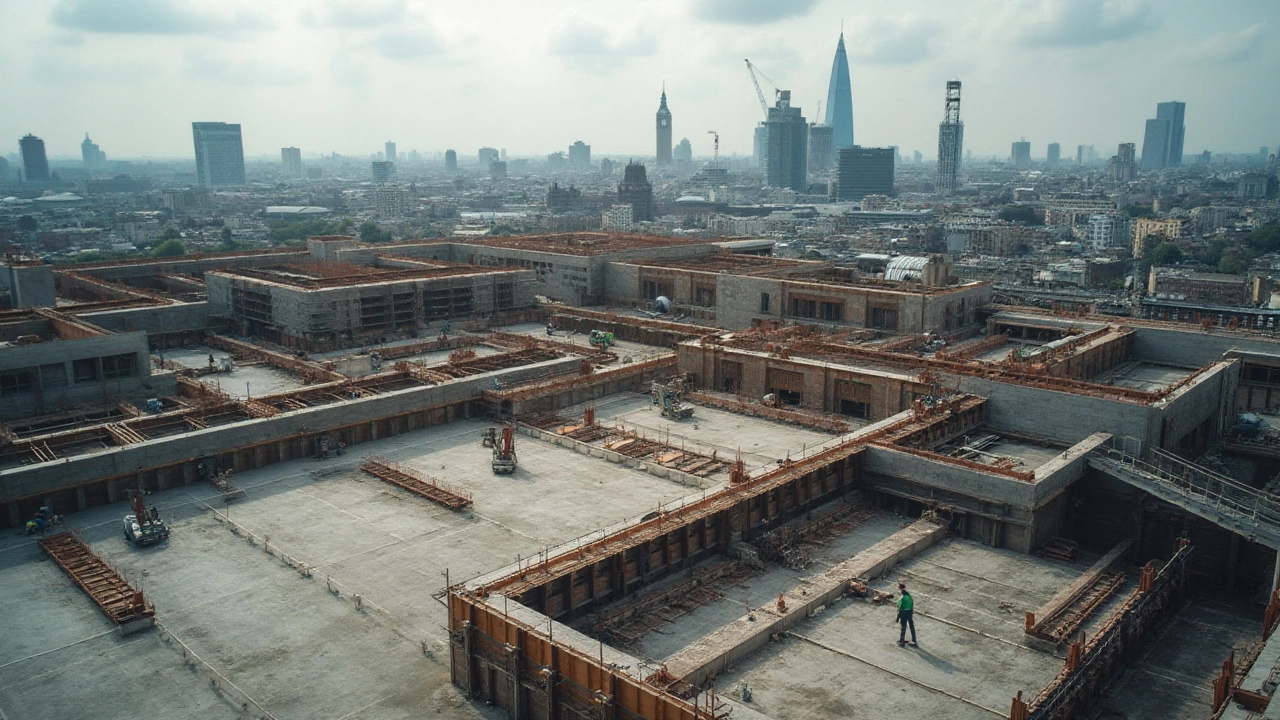The world of commercial construction is filled with rules and guidelines meant to ensure every structure stands tall and safe. Among these principles, the 345 rule holds a special place, especially in laying a foundation that's not just sturdy but also accurately aligned. This rule, straightforward in its application, works like a trusty old friend for anyone wielding a measuring tape on site.
Famed for its connection to the Pythagorean theorem, the 345 rule is about creating perfect right angles—essential for constructing anything from a simple wall to a complex building. It's a clever bit of math that provides a quick check to make sure your angles measure up just right.
Understanding and using the 345 rule efficiently can be the difference between a smooth build and a costly mistake. Let's dive into what makes this rule a cornerstone in the world of construction, both literally and figuratively.
- Introduction to the 345 Rule
- Historical Origins and Applications
- Practical Examples in Construction
- Benefits of Using the 345 Rule
- Common Mistakes and How to Avoid Them
Introduction to the 345 Rule
In the realm of construction, precision isn’t just a nicety; it’s an absolute necessity. Whether you’re an experienced builder or a rookie on the site, the significance of getting angles right cannot be overstated. Enter the 345 rule, a cornerstone in ensuring the alignment is correct and the construction is sound. This ancient guideline is as prevalent today as it was centuries ago, when builders first realized the critical importance of creating true right angles while building. At its core, the 345 rule is a practical application of the Pythagorean theorem, which helps in forming a right angle triangle. Simply put, if the sides of a triangle measure 3, 4, and 5 units respectively, the angle opposite the longest side—also known as the hypotenuse—is a right angle. This knowledge has enabled builders to check their work quickly and effectively, ensuring a proper angle without the need for complex instruments or calculations.
One might wonder about the origins of this rule and its continued prominence. Historically, the 345 rule has been a trusted ally from the times of ancient Egypt, where it’s believed that laborers used the technique to construct the great pyramids with astounding precision. Fast forward to the modern era, the utility of the 345 rule persists not out of nostalgia, but out of necessity. When constructing any framework, be it the base of a house or the steel skeleton of a skyscraper, starting with a square foundation is imperative. Giving builders an efficient way to double-check right angles without relying solely on digital tools prevents a host of potential issues as the project progresses.
This method promotes quality and safety, pivotal components in the industry. Even with technological advances, the need to maintain stringent safety and accuracy standards remains. The widespread trust in the 345 method underscores its role not just as a tool but as an educational touchstone that highlights the blend of simplicity and efficacy. It’s why builders consistently return to this technique—in part because it's reliable, but also because it acts as a fundamental piece of practical mathematics, alive and kicking since ancient civilizations first grasped the principles of geometry.
"In construction, as in life, the right angles serve as the foundation of stability," said a well-regarded architectural historian, emphasizing the simple yet profound impact of the 345 rule.
Learning about this principle is more than just acquiring knowledge; it's about understanding the very mechanics of how structures stand unyielding against the test of time. It's teaching and enabling builders to respect the geometry that defines their craft. Quick manual checks are invaluable, especially when technology might fail or is impractical. This rule empowers workers with the means to execute their roles with confidence. Within the practical scope of commercial construction, leveraging the 345 rule delivers a balance of efficiency and dependability, making it an indispensable part of the construction toolkit.
Historical Origins and Applications
The 345 rule is a cornerstone of practical mathematics that has been used by builders and architects for centuries. This rule can be traced back to ancient civilizations, including the Egyptians and Babylonians, who used basic principles of geometry long before calculators and computers. Its roots lie in the Pythagorean theorem, a mathematical concept dating back to roughly 500 BC, formulated by the Greek philosopher Pythagoras. The theorem states that in a right triangle, the square of the hypotenuse is equal to the sum of the squares of the other two sides. In simpler terms, the rule provides a quick, reliable way to form a perfect right angle, which is crucial in construction for ensuring structural integrity.
In medieval times, builders used a string version of the 345 triangle to ensure their stone walls were not just level but aesthetically pleasing too. This tangible tool was vital before the advent of precision instruments, offering craftsmen a practical way to achieve geometric perfection using only ropes with evenly spaced knots. Over time, as the science of construction and architecture evolved, the 345 rule remained a simple yet effective method for achieving accuracy. It found its place in the modern building toolkit, ensuring corners aren't just sturdy but precisely angled for maximum stability.
To this day, the rule is deeply ingrained in various construction practices. Whether setting the foundation for a skyscraper or pouring concrete for a sidewalk, ensuring right angles is essential. It is also an invaluable teaching tool for budding architects and engineers, illustrating how ancient mathematical principles remain relevant. It exemplifies the intersection of knowledge passed down through generations, combined with contemporary construction techniques. As newer builders enter the workforce, the rule continues to teach the enduring lesson that precision is key. This simple rule is not just about perfect angles but also serves as a reminder of the importance of accuracy in building a structure people can trust.
The Rule's Timeless Value
In practical applications, the 345 rule may seem almost magical in its simplicity. One simply measures out from a point, creating sides proportioned to create a perfect right angle at its vertex. Builders and surveyors alike rely on this rule to quickly establish perpendicular lines or corners, which is evident in property demarcations and road layouts. Its utility extends beyond construction, aiding professions such as land surveying and even in artistic canvases where geometry creates balance. The 345 rule acts as a connector, bridging time-tested geometry with present-day demands for accuracy and safety.
"Understanding foundational geometry principles like the 345 rule is vital for the integrity of any structure," says architect John Lassiter. "It echoes throughout the history of design and construction, continuously proving its worth even as new technologies emerge."
Looking back at its historical uses, the 345 rule reminds us of the wisdom in simplicity and the human capacity to harness simple truths to solve complex problems. Teachers in engineering schools often emphasize this rule, encouraging students not just to memorize formulas, but to appreciate their historical significance and real-world applicability. As techniques and tools evolve, the enduring relevance of such basic principles offers both a link to the past and a guide for future innovations. It helps maintain the legacy of robust and enduring structures, echoing the timelessness of geometry.

Practical Examples in Construction
Walking onto a construction site, you might witness the 345 rule in action more times than you can count, yet still not recognize its impact without a deeper understanding. This rule is often employed when workers set the foundation for a new building or prepare to lay the corners for a structure. The rule is a game-changer, allowing construction teams to create precise 90-degree angles without the aid of complex equipment. This is crucial because maintaining right angles ensures that walls are perfectly aligned, eliminating the risks of skewness that could lead to structural weaknesses over time.
Take, for example, the setup of concrete forms. In this context, the 345 rule comes into play as a fundamental guideline to verify the accuracy of angles before pouring begins. By measuring 3 units along one side, 4 units along the adjacent side, and ensuring the diagonal measures 5 units, workers guarantee that their corners are true right angles. This measurement technique is not only simple but highly effective. In projects where time and precision are of the essence, this can markedly enhance efficiency, leading to quicker project turnarounds while maintaining high-quality standards. In fact, many construction companies train new workers rigorously on this rule, ensuring everyone on the team can execute it flawlessly.
Another practical example occurs during framing. Imagine erecting a wooden frame for a single-family home. Carpenters first lay out the base of the house, marking where each corner of the house will sit. By applying the 345 rule, these craftsmen confirm that each corner is perfectly squared. This precision is critical when you consider that even a tiny error can multiply as walls are raised and the roof is laid atop. A precisely squared base with the 345 rule's help ensures that subsequent phases of construction proceed without unnecessary challenges, such as misaligned roof trusses or misfitting door frames.
"Precision is the soul of any construction project, and the 345 rule is where it begins. If you mess up the basics, the rest of the building will give you endless trouble," shared renowned architect Lorenzo Garcia, emphasizing the rule's importance.
To illustrate the importance, let’s explore it in the setup of pathways within a commercial landscape project. Here, the need for perfectly perpendicular corners is less obvious but equally crucial. A pathway must meet roads and parking lots at precise angles for aesthetic appeal and safety. Using the 345 technique helps landscapers visualize and verify the positioning of paths so that the angles enhance usability and appearance, much like ensuring a picture frame is perfectly aligned on a wall.
Now, consider how the 345 rule impacts the layout of interior spaces like offices and retail fronts. Designers rely on the rule to set partitions and exhibit stands, making sure that the layout remains logically arranged and visually pleasing. In environments where public footfall is high, ensuring these angles are correct can improve flow and accessibility, ultimately influencing consumer experience and business success. It’s amazing how such a straightforward math concept can weave its way into the critical aspects of constructing functional and appealing commercial spaces.
Benefits of Using the 345 Rule
One of the primary advantages of applying the 345 rule in commercial construction is its simplicity and effectiveness in ensuring accurate right angles without the need for sophisticated tools. Whether you're laying out a foundation for a skyscraper or a small commercial building, using the 345 rule ensures your angles are precise, vital for structural integrity. This rule, originating from the mathematical brilliance of the Pythagorean theorem, is a quick go-to for engineers and workers alike, ensuring that walls, foundations, and other crucial elements are square. This minimizes the potential for costly errors later in the project lifecycle. Engineers love it because it turns laymen into geometry wizards on site, aiding them in laying out clean, straight lines and perfect squares with ease.
Additionally, the 345 rule doesn't just aid in the geometrical aspect of building techniques. It supports safety guidelines, which is a critical component in construction. Right angles contribute to the overall stability of structures. A miscalculation or misalignment could lead to dire consequences, especially in commercial constructions where integrity and strength are paramount. By ensuring that the foundations are perfectly squared, you lay the groundwork for a reliable and safe build. Even slight deviations from a right angle can have negative cumulative effects as the structure rises, potentially leading to significant structural faults or failures.
Another remarkable benefit of the 345 rule is how it enhances efficiency on site. With a simple measurement of three feet, four feet, and the diagonal being five feet, one can confirm each corner of a layout frame is a perfect right angle. This saves substantial time compared to using more complex and time-consuming methods. The time saved translates into faster project completion times and better adherence to budget constraints. Experienced construction managers know that less time spent adjusting structures means more time spent on the rest of the project, keeping everything on schedule. As one industry veteran put it, "It's a small rule that delivers big savings."
Notably, implementing the 345 rule is cost-effective. Precise measurements reduce material waste, which is financially beneficial. In commercial construction, where material costs can be significant, ensuring every cut and placement is correct the first time helps significantly with cost management. For a quantitative perspective, consider this: even a 10% reduction in material waste can lead to a noticeable improvement in profit margins for construction firms.
The 345 rule is versatile, too. It's not confined to large-scale commercial projects; it's equally practical for smaller constructions or renovations. It's a rule that easily adapts to various levels of construction complexity. The consistent application of this principle in diverse contexts – whether in designing a luxury shopping mall or a warehouse facility – underscores its universal value. This adaptability makes it a fundamental tool in the construction industry, where different projects demand unique requirements but still need robust underlying foundations.

Common Mistakes and How to Avoid Them
In the hustle and bustle of a construction site, where every minute counts, it's all too easy to overlook the small steps that might seem trivial at first but can have a big impact later. One common mistake when using the 345 rule is not double-checking the measurements. It might be tempting to eyeball an angle or assume the lines are good when you're in a rush to meet a deadline. But assuming accuracy without verification can lead to errors. These can manifest as anything from slightly uneven walls to complete misalignments of structures. Such errors aren't just costly to fix; they can compromise the safety of the entire construction project.
Another pitfall to beware of is relying on poor-quality tools. The trusty measuring tape that’s been in your tool kit for a decade might have seen better days. Wear and tear can stretch a tape out, and marks can fade. Investing in high-quality, reliable tools is a wise use of your budget, ensuring the construction is both safe and effective. Remember the adage frequently quoted in workshops, "Measure twice, cut once." These words remind us that precision in preparation is worth its weight in gold.
Factors like terrain and environmental conditions can drastically affect measurements as well, introducing the need for adequate planning. Uneven or unstable ground can throw off calculations, leading to structures being slightly off-kilter. In such scenarios, it's important to adjust the 345 rule application by taking more frequent measurements to verify the angles, especially when the site conditions are less than perfect. Strong winds or vibrations from heavy equipment nearby can lead to inaccuracies, necessitating stable reference points for the rule to be truly effective.
A major underestimation seen in commercial construction involves overlooking the importance of training. The simplicity of the 345 rule often results in it being taught on the fly, which can lead to misunderstandings. New workers might not appreciate the significance of precision until they've seen a mistake arise firsthand. To avoid this, detailed training sessions should highlight potential pitfalls and the importance of this rule. Workers should be encouraged to ask questions and practice until they fully understand both the theory and its practical applications.
Lastly, always documenting the process is crucial yet often neglected. By keeping records of measurements and checks, especially in large-scale builds, you offer yourself a paper trail that can catch errors before they escalate. It's handy for reflecting on methods that worked well and those needing improvement. This creates a learning environment that benefits current and future projects alike. If all involved parties adhere to these guidelines and take these pitfalls seriously, issues can be proactively solved rather than reactively patched.
As renowned civil engineer John Doe wisely stated, "Time spent in preparation saves more than the effort spent in correction later."

Author
Damon Blackwood
I'm a seasoned consultant in the services industry, focusing primarily on project management and operational efficiency. I have a passion for writing about construction trends, exploring innovative techniques, and the impact of technology on traditional building practices. My work involves collaborating with construction firms to optimize their operations, ensuring they meet the industry's evolving demands. Through my writing, I aim to educate and inspire professionals in the construction field, sharing valuable insights and practical advice to enhance their projects.